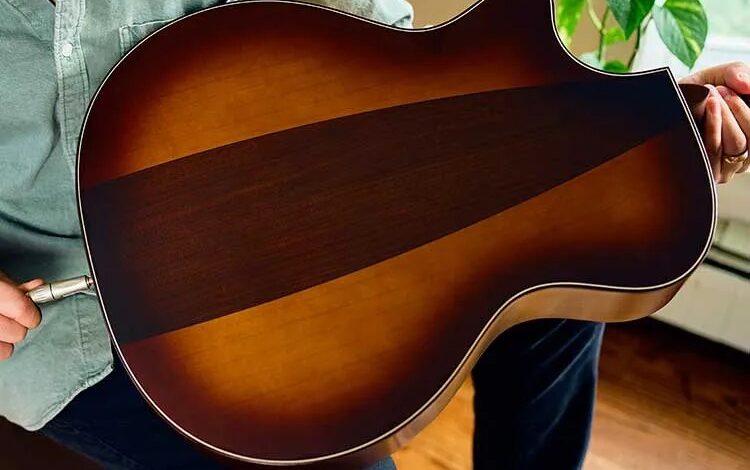Review: The Martin GPCE Inception Maple Looks to the Future of Tonewoods and Guitar Design

Ever since C.F. Martin & Co. first set up shop in America nearly 200 years ago, its instruments have been the gold standard for acoustic guitars. For a legacy company such as Martin to name a new model Inception, one should consider what this might be the beginning of. With a continuing decline in the availability of traditional hardwoods due to tropical deforestation, the guitar industry faces the existential crisis of how to build high-quality instruments from sustainable woods. Martin is starting to answer that question with the GPCE Inception.
Using sustainable domestic tonewoods paired with an innovative bracing design, the Inception is a great-sounding instrument that is easy to play, produces robust projection, and is balanced across the sonic spectrum. On a recent test, I found the guitar to be a well-rounded and likeable, providing ample tone whether fingerpicking, strumming, or soloing.

Sustainably Built and Cleverly Designed
Martin has for the most part built guitars with rosewood and mahogany bodies, only occasionally using maple on production models such as the short-lived J-65 and the occasional custom shop build. What is different about the Inception is that the design team carefully constructed the guitar with maple in mind and didn’t simply recycle a historic model with different woods. The back of the Inception has not the traditional two-piece design but a three-piece layout, which allows Martin to select wood from smaller trees.
This project also provided an opportunity for a unique and functional design. Since the quick fundamental of maple can be brash in a steel-string guitar, Martin used a black walnut wedge on the center of the back to sweeten up the tone. The use of these two domestically harvested woods is seen throughout the guitar in its maple sides and black walnut bridge, binding, neck, and fretboard. Meanwhile, the top is made of FSC-certified European spruce.
Under the hood, the Inception looks quite different than anything the guitar maker has ever done. This is not your grandmother’s Martin. Laser-cut hexagon honeycomb shapes in the Inception’s bracing system take out some of the weight and aim to make the top more responsive—an effect aided by tone channels stemming from each of the braces.
Martin’s attention to detail and artisanship is evident throughout the Inception. The frets are well-seated and intonated throughout. The sheen of the satin finish blends well with the black walnut fretboard, and the sunburst on the back illuminates its walnut strip. Inside the box, the visible joints are spot on, with no glue spillage in sight.

Excellent Playability and Modern Sound
The Inception plays as easily as an electric guitar with its low action and modified low oval neck. With a nut width of 1-3/4 inches, there’s plenty of room between the strings for single-note soloing, but not too much to make certain chord shapes challenging.
While the new bracing system is said to increase the amplitude of the sound wave, playing the guitar was the ultimate test, and I quickly noticed it was surprisingly loud. There was an immediacy from the attack of my pick to the opening of the note, likely owing to the maple construction. However, I had to be cautious not to dig in too hard, as I found the guitar set up for a gentler player. The Inception was well balanced across the fretboard until I got past the 15th fret—that’s an area where most guitars lose their punch, and the test model was no exception.
To really put the guitar through its paces, I played a handful of original compositions combining arpeggiated chords with melodic outbursts and found my personal sweet spot a little closer to the bridge than I would normally play. I veered into Eddie Lang’s “A Little Love, A Little Kiss” and quickly realized I needed to lighten up on the bass notes and push a little harder on the high end to get it balanced while using a plectrum.
I then put the pick down and finger-picked my way through a bossa-nova rhythm on Antônio Carlos Jobim’s “Waters of March,” followed by Ernesto Nazareth’s “Odeon.” It was here that the Inception excelled, as I easily found the right balance between bass and chords. I then went back to strumming with a pick and played through David Bowie’s “Ziggy Stardust.” The open chords sustained and projected bountifully and without any muddiness.

Plugging In
To put the Inception’s L.R. Baggs Anthem electronics to the test, I plugged the guitar into my Henriksen Blu Six combo amp. The amplified signal possessed impressive transparency. It sounded just like the guitar, only with more volume—a testament to both the guitar and its pickup system, as well as the amp. Play-ing at a range of apartment-acceptable volume levels, I found the sounds consistently good, and I quickly discovered that dialing down the volume of the guitar allowed me to turn up the amp without the bass overriding the treble.
The Verdict
Overall, the Martin GPCE Inception Maple is a bold new acoustic-electric that is perfect for a gigging contemporary singer-songwriter or instrumentalist—especially one who is ecologically conscious and open to advancements in steel-string acoustic design. The folks at Martin have made it clear: the Inception is the beginning of a bright future of sustainably built guitars.
SPECS
BODY Grand Performance 14-fret cutaway; FSC-certified European spruce top with skeletonized scalloped X-bracing; three-piece maple and black walnut back; maple sides; black walnut sloped modern belly bridge with drop-in Tusq saddle; bone bridge pins; black walnut binding; tortoise pattern pickguard; satin finish with Amber Fade sunburst top
NECK Black walnut neck; modified low oval shape with high-performance taper; dovetail joint; 25.4″ scale length; 1-3/4″ bone nut; black walnut fretboard; maple arrow hex design inlays; 20 frets; gold open gear tuners; satin finish
OTHER L.R. Baggs Anthem electronics; Luxe by Martin Kovar strings (.012–.054); molded hardshell case; available left-handed
MADE IN USA
PRICE $3,999 street
This article originally appeared in the May/June 2024 issue of Acoustic Guitar magazine.




